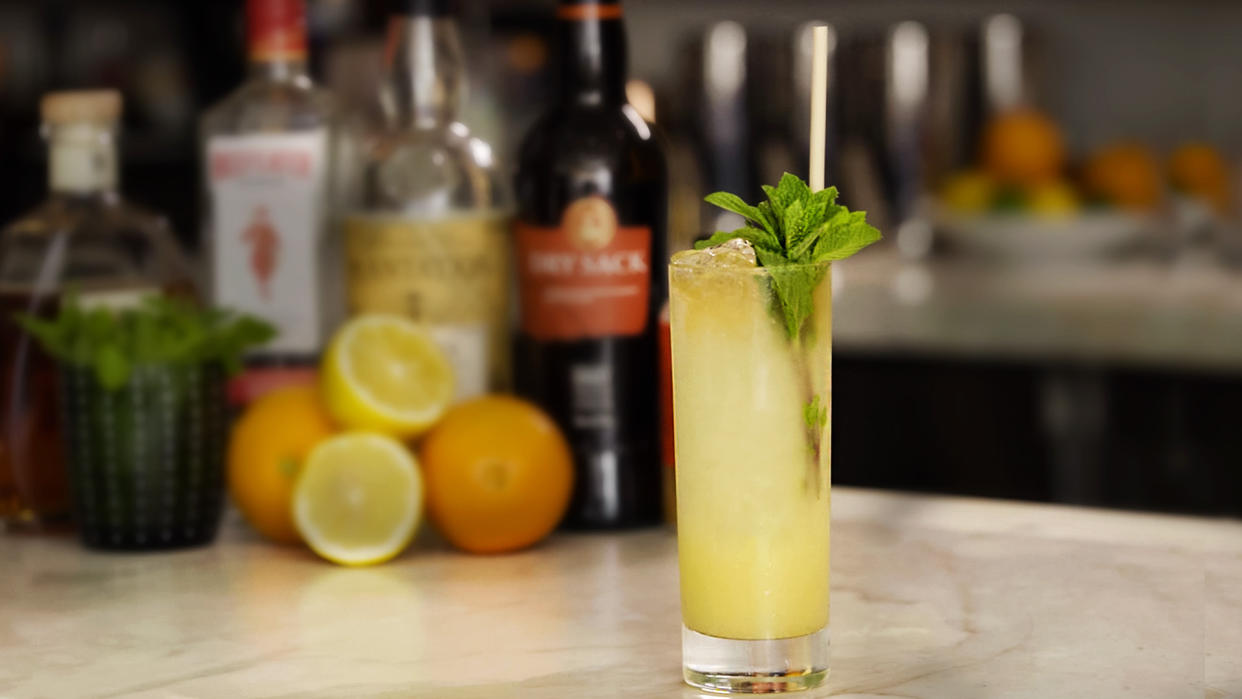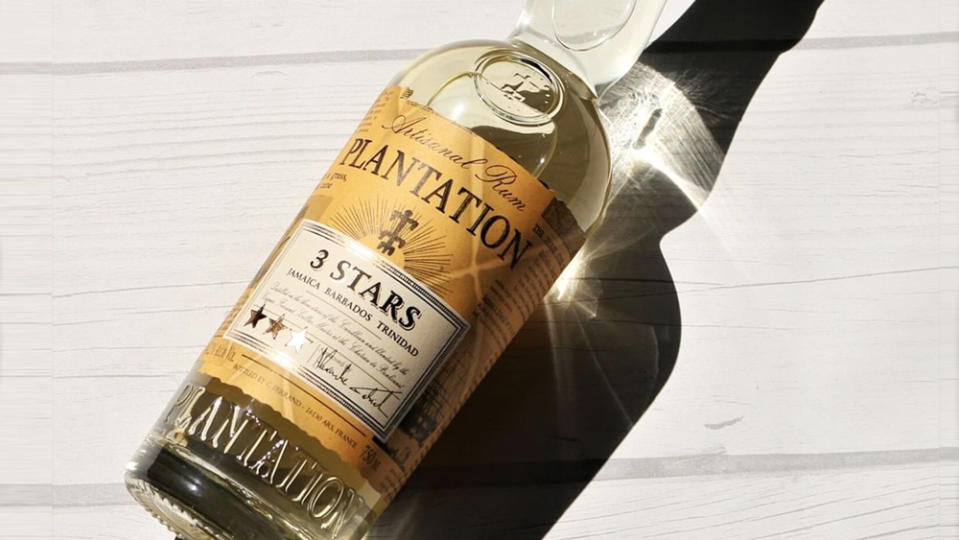How to Make a Fog Cutter, a Boozy Tiki Cocktail That’s Actually Delicious to Drink

There’s a stereotype of tiki bartenders that goes something like this: They’ll take a rum, add another rum, and some lime juice, and then throw in between two to four of the following: Grenadine, falernum, allspice, orgeat, pineapple, curaçao, cinnamon, or coconut. They taste it, shake each other’s hands on another job well done, and sip on it while they continue listening to plasticized music and wearing unpardonable shirts.
This is mean, and the reason it’s mean is that it’s half true (had I said that tiki people were always riding unicycles and doing long division, it wouldn’t be mean, it would be dumb). Tiki drinks are essentially the same dozen ingredients reshuffled ad-nauseum, like a Taco Bell menu but with juice and spice instead of cheese and beans. Most tiki fans acknowledge this and simply don’t care. . .but if you ever find yourself at a tiki bar and are feeling particularly aggrieved on this point, you should think about ordering a Fog Cutter.
More from Robb Report
Moët Hennessy Just Opened a Swanky New Cocktail Bar in the Heart of Paris. Here's a Look Inside.
The WhistlePig Founder's New Company Just Dropped a 26-Year-Old Rum for Whiskey Drinkers
The Fog Cutter is a Trader Vic original from the mid-’40s. It was, after the Mai Tai and the Scorpion Bowl, his third-most-popular creation, which is kind of insane given what’s in it. For starters, there’s almost four full ounces of alcohol in there, which is a lot but not exactly unprecedented for the genre; tiki drinks are what you use when conventional weaponry is insufficient. But beyond that, it’s just a weird drink—for every classic tiki ingredient, there’s one pulled out of nowhere. Sure there’s orgeat, but there’s also cream sherry. There’s rum, but there’s also both brandy and gin. No less of a tiki authority than Jeff “Beachbum” Berry calls the cocktail “the Long Island Iced Tea of exotic drinks” and it’s hard to argue with his assessment, save for one very important difference: The Fog Cutter is good.
For all their nets and buoys and random flotsam, for all the elaborate ceramic mugs and baroque garnishes and angry totemic faces, what’s very often forgotten about tiki is just how delicious, layered, and mature the cocktails can be. Both of the fathers of tiki—Donn Beach, who created the genre whole out of his imagination, and “Trader” Vic Bergeron, his most successful imitator—were masters of flavor and balance. Take the Fog Cutter: The recipe honestly looks like some drunk copyeditor lost his place and accidently shoved two drinks together, but try one and you’ll see. The nutty richness of the sherry is immediately apparent, sweetened and charmed by the orgeat, and the sherry as much as anything is what sets the Fog Cutter apart. The rum’s bright tropicality and the cognac’s oaky fruit meet right at the front palate and play back and forth, and the gin’s spiky juniper only comes in towards the end, a little textural contrast in a broad and juicy experience, and what keeps me coming back for more.
Like Donn Beach’s Zombie, Trader Vic’s menu originally limited the Fog Cutter to two per person. Have a couple of these monsters, and even the most stubborn tiki curmudgeon might start to find the music charming and the outfits festive, and more importantly, begin to see the variety available in this boozy world of make believe. Or maybe not. Maybe they’ll see none of these things. It depends on the person. As Trader Vic himself said, “Fog cutter, hell. After two of these, you won’t even see the stuff.”
Fog Cutter
1.5 oz. rum
1 oz. Cognac
0.5 oz. gin
1 oz. lemon juice
1 oz. orange juice
0.75-1 oz. orgeat
0.5 oz. sherry
Add all ingredients except sherry to a cocktail shaker with crushed ice, and “whip” shake briefly—about three to five seconds. Pour into a tall glass, fill with more crushed ice, and top with the sherry. Garnish with a mint sprig.
Notes on Ingredients

Proportions: I’ve reduced the rum by a half ounce, but beside that and the lemon juice, these proportions are historically accurate. Go ahead and reinstate the extra rum if you’d like to, but personally, I think 3 oz. of alcohol (plus a half ounce of sherry) in a single drink is plenty.
Beyond that, the only other thing to say is that the measure of orgeat is in a range because the final balance of the drink will depend on the rum, the cognac, the orange juice, and the sherry, all of which have variable levels of sweetness. Make one and try it. If it’s too tart, increase the orgeat 0.25 oz. at a time until it’s not too tart anymore.
Rum: Trader Vic specifically calls for a light rum here. You can use something lightly aged, like Mt. Gay Eclipse or Plantation 5, but the rum is supposed to be adding bright tropical notes, so you can leave the oaky richness to the cognac. My favorites are Flor de Cana 4, Ron Matusalem, and Plantation 3 Star.
Cognac: Cognac’s job is to add richness and oak, so grab a VSOP or older. Any well-aged Cognac or brandy will be great, no need to worry too much about specific brands.
Gin: The gin’s role here is to add some prickly juniper on the finish, so get one that has a lot of that. The London Dry giants are perfect for this, and my favorite version for shaken drinks is the affordable and delicious Beefeater.
Orgeat: Orgeat is an almond syrup and you can make it if you have a mind to, but for at home work, even I usually just go buy it. It can come in marzipan-forward versions and in almond-forward versions, and I strongly prefer the latter—my favorites that are available in my part of the world are Liquid Alchemist, Small Hands Foods, and Liber & Co. Brand availability may vary by location but be sure to grab something made from real almonds. The more artisanal, the better.
Lemon: The original recipe calls for a frankly insane 2 oz. of lemon juice. I suppose as this has double the alcohol, Vic went ahead and doubled the lemon as well. This is too much. I bring it down to 1 oz.—still 33 percent higher than a normal sour, but not so much that this is a big sour lemonade.
Orange: While I’m usually always banging on about how you need to juice your oranges fresh for every drink, it actually doesn’t really matter here. The orange juice’s job is to add pleasant citrus sweetness and to thin out the intensity of all that booze. It’ll still be better if you use fresh, but just this once, if you’re feeling lazy, you can cheat with Tropicana.
Sherry: The original recipe calls for “cream” sherry, which usually just means a sweet oloroso (there’s no dairy, I promise). The flavor is super important, but the sweetness isn’t because you can always use more orgeat, so shop for flavor. Sherry can either have oxidative notes or not, and for here, you want the oxidative ones—Amontillado works, but better still is to grab an Oloroso from any producer, or the commonly available Lustau East India Solera.
Best of Robb Report
Why a Heritage Turkey Is the Best Thanksgiving Bird—and How to Get One
The 10 Best Wines to Pair With Steak, From Cabernet to Malbec
Sign up for Robb Report's Newsletter. For the latest news, follow us on Facebook, Twitter, and Instagram.

